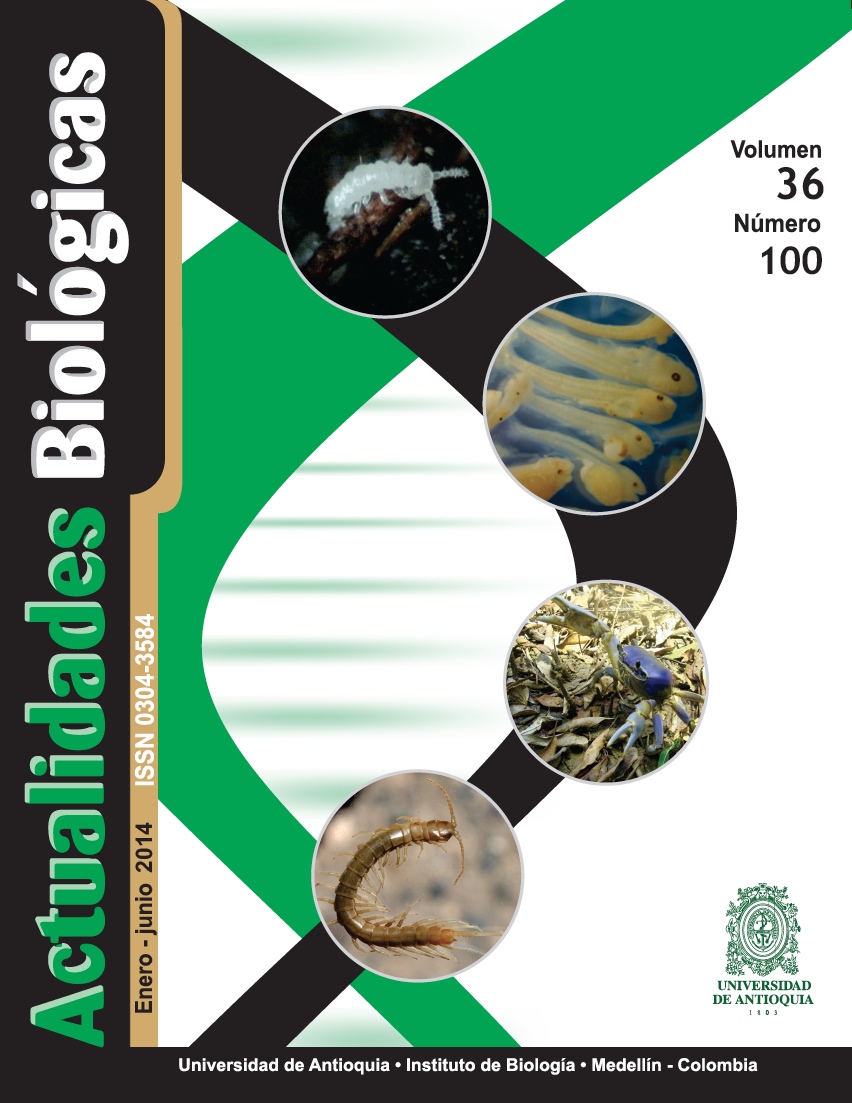Records of centipedes (Chilopoda) and millipedes (Diplopoda) species from Sinaloa, Mexico
DOI:
https://doi.org/10.17533/udea.acbi.329112Keywords:
Arthrorhabdus, Aspidiophan, Aztekophilus, Myriapoda, Rhysida, Scolopendra, SinaloaAbstract
A checklist of the centipedes. (Chilopoda) and millipedes (Diplopoda) species recorded in Sinaloa, Mexico, is provided. Currently, seven species and one subspecies of centipedes and one species of millipedes are known to occur in the state. Two species and one subspecies are endemic to Mexico: Aztekophilus (Thylakiophilus) Mexicans, Scolopendra octodentata, and S. Viridian genuina. One millipede species is endemic: Aspidiophan divisum. The checklist includes collecting localities in Sinaloa.
Downloads
References
Bueno-Villegas J. 2012. Diplópodos: los desconocidos formadores de suelo. Biodiversitas, 102: 2-5.
Bueno-Villegas J, Sierwald P. Bond JE. 2004. Diplopoda. En: Llorente-Bousquets JE, Morrone JJ, Yáñez-Ordóñez O, Vargas-Ferná nuez I, editores. Biodiversidad, taxonomía y biogeografía de artrópodos de México: hacia una síntesis de su conocimiento, Vol. IV. México: UNAM-CONABIO. p. 569-599.
Cupul-Magaña FG. 2009. Nuevas localidades para quilópodos (Chilopoda) en la costa de Jalisco y Sinaloa, México. Dugesiana, 16 (2): 81-85.
Cupul-Magaña FG. 2010. El ciempiés: un bicho que se parece al borde de un petate viejo. Biodiversitas, 88: 8-11.
Cupul-Magaña FG. 2011. Los mariápidos en el libro de Moisés Herrera. Elementos, 83: 15-17.
Cupul-Magaña FG. 2013. La diversidad de los ciempiés (Chilopoda) de México, Dugesiana, 20 (1): 17-41.
Cupul-Magaña FG, González-Salazar C, 2011. Distribución potencial para México de cuatro especies de ciempiés (Myriapoda, Chilopa). Boletín de la Asociación Española de Entomología, 35 (1-2): 295-299.
Grimaldi D, Engel MS. 2005. Evolution of the insects. Cambridge (U. k.): Cambridge University Press. p. 755.
Minelli A. 2011. Class Chilopoda, Class Symphylan and Class Pauopoda. En: Zhang Z-Q, editor. Animal biodiversity: An outline of higher -level classification and survey of taxonomy richness. Zootaxa, 3148: 157-158.
Minelli An, Kcoh M. 2011. Chilopoda: General morphology. En Minelli A, editor. Treatise on Zoology -Anatomy, taxonomy, biology: the Myriapoda. Leiden (Países Bajos): Brill. p. 41-66.
Pocock RI. 1895-1910. Chilopoda and Diplopoda. Biología Centrali-Americana, 14: 1-127.
Sánchez-Vargas DA. 2002. Arácnidos y miriápodos: alacranes, arañas, ciempiés y otros parientes artrópodos poco conocidos. En Cifuentes-Lemus JL, Gaxiola-López J, editores. Atlas de la biodiversidad de Sinaloa. México: El Colegio de Sinaloa. p. 211-219.
Shear W. 2011. Class Diplopoda de Blainville in Gervais, 1844. En: Zhang ZQ, editor. Animal biodiversity: An outline of higher -level classification and survey of taxonomic richness. Zootaza, 3148: 159-164.
Shelley RM. 2000. A new callipodoid millipede genus and species from Sinaloa, with the proposal of a new tribe in the subfamily Tynommatinae (Schizopetalidea) Myriapodologica, 6 (9): 83-86.
Shelley RM. 2002. A synopsis of the North American centipedes of the order Scolopendromorpha (Chilopoda). Virginia Museum of Natural History Memoir, 5: 1-108.
Shelley RM. 2006. A chronological catalog of the New World species Scolopendra L., 1758 (Chilopoda: Scolopendromorpha: Scopendridae). Zootaxa, 1253: 1-50.
Shelley RM, Changas-Júnior A. 2004. The centipede genus Arthrorhabdus Pocok, 1891, in the Western Hemisphere: potencial occurrence of A. Pygmaeus (Pocock, 1894) in Belize (Scolopendromopha: Scolopendridae: Scolopendrinae). Wstern North American Naturalist, 64 (4): 532-537.
Shelley RM, Kiser SB. 2000. Neotype designation and a diagnostic account for the centipede, Scolopendra gigantic L. 1758, with an account of S. galapagoensis Bollman 1889 (Chipoda Scolopendromorpha Scolopendridae). Tropical Zoology, 13: 159-170.
Verhoeff KW. 1934. Beiträge zur systematic und geographic der chilopoden. Zoologische Jahrbücher, Abteilung für Systematik, Ökologie und Geographie der Tiere, 66: 1-112.
Yang S, Xiao Y, Kang D, Liu J, Li, Y, Undheim EAB, Klint JK, Rong M, Lai R, King GF. 2013. Discovery of a selective NaV1.7 inhibitor from centipede venom with analgesic efficacy exceeding morphine in rodent pain models. Proceedings of National Academy of Sciences of the United States of America, 110 (43): 17534-17539.
Downloads
Published
How to Cite
Issue
Section
License
The authors exclusively authorize the Actualidades Biológicas journal to edit and publish the submitted manuscript if its publication is recommended and accepted, without this representing any cost to the Journal or the University of Antioquia.
All the ideas and opinions contained in the articles are sole responsibility of the authors. The total content of the issues or supplements of the journal is protected under the Creative Commons Attribution-NonCommercial-ShareAlike 4.0 International License, so they cannot be used for commercial purposes, but for educational purposes. However, please mention the Actualidades Biológicas journal as a source and send a copy of the publication in which the content was reproduced.












